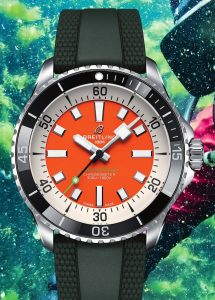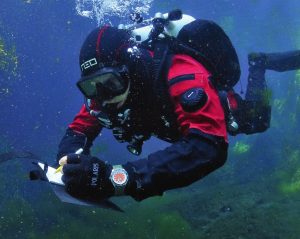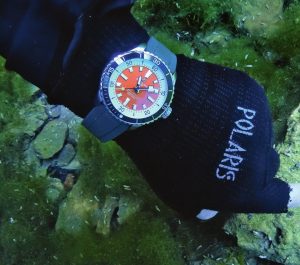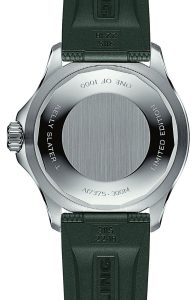He did it again. Georges Kern, Breitling’s highpowered CEO, has relaunched another important watch line based on his “Modern Retro” design concept. The instructions were the same as for the Superocean Heritage, the Premier and the Chronomat: Take a historical Breitling model and design a new watch on that basis, but not an exact copy. Instead, the essential components are carefully selected, brought together in a modern format, and combined with additional elements to meet today’s expectations for style and comfort. As a rule, this produces an attractive new watch that is offered in a range of different versions.
Kern has been very successful with this approach so far. He has turned the once clearly positioned pilots’ watch brand into a lifestyle brand that feels at home in the air but also on land and water and utilizes the full potential of its rich history. perfect Breitling copy watches are attractive and highly desirable. And by combining the informal, sporty brand image and a cool boutique concept, Swiss fake Breitling has flourished since its 2017 acquisition by the financial investor CVC.

The numbers prove it. CVC paid around 800 million euros for an 80-percent share, and by autumn 2021, Breitling was valued at an estimated 3 billion euros. At that time, the Partners Group, another investment company, purchased approximately 25 percent of Breitling for a rumored three-quarter of a billion euros.
Breitling is booming, and Georges Kern can cite a number of successes. Still, we do sometimes wonder how long the brand will continue to benefit from this approach. All of Breitling’s corners and edges are gradually disappearing, and distinctive models like the Navitimer or the Chronomat now have a more widely appealing look or like the Emergency, with its 51-mm diameter and distress beacon function, can only be found at the fringes of the collection. The thing about corners and edges applies quite literally to the Chronomat, whose screwed-on bezel rider tabs will no longer catch and tear your sweater, but which no one talks about anymore. And last of all, the new Navitimer — it comes in a truly attractive array of color variants and case sizes, including three-hand watches and women’s models. Although this offers something for a wide range of tastes, it dilutes the iconic pilots’ watch design with the black dial and three white subdials.![]()
Kern and his team also followed the Modern Retro principle in their approach to the Superocean. Again, a specific historical model served as the basis for the new collection. But one thing is different from the other examples cited above: The new Superocean is more than just good looking. It has one polarizing detail — its distinctive minute hand. It is much thinner than the hour hand and also has a large square inlay. That alone sets it apart. But because the minute hand is narrow and also tapers toward the end, and because the square is set quite far from the center, it looks a little top-heavy. It creates a clear contrast which, depending on the viewer’s personal opinion, can be seen as either exciting or off-putting. The hand projects a feeling of heaviness that’s not a great look for a sports watch. But that’s not the whole story.
The historical prototype of the new Superocean is one of the lesser-known models in Breitling’s past. Inspiration for the 2022 edition came not from the first Superocean from 1957, but from a model introduced in the 1960s: a chronograph known as the Slow Motion. Several versions of this model were available even then. The one we’re interested in is dominated by a distinctive hand that looks identical to the minute hand of the new model. The difference is, of course, that then it was a centrally mounted minute counter of the chronograph. This meant that the diver could simply start the chronograph in order to measure time spent under water, and then read the minute track. The rotating bezel even made it possible to register a second time interval. The special thing about this watch was that it had no centrally mounted second hand, only a small seconds subdial at 9 o’clock. The central counter hand moved 60 times more slowly than a seconds counter, so this dive watch was called the Slow Motion. This slow movement of the counter hand presented a risk for divers who couldn’t see at first glance whether the chronograph was running at all. Breitling compensated for this by adding a functional display at 6 o’clock that showed green when the chronograph was running, and black with a green dot when the chronograph was paused and reset.
That idea was a complicated one and did not last. But the design with the eye-catching hand, reflecting the look of the block-like hour markers, inspired Georges Kern and his team and served as a basis for the new Superocean. This model is not, however, a chronograph, but a three-hand watch with a centrally mounted, sweep seconds hand. The distinctive hand with its square insert is now the minute hand, and the dive time is measured, as is usual, with the rotating bezel. The functional indicator and small seconds subdial are gone.![]()

The new watch features three essential design elements: the distinctive minute hand, the block-like hour markers and the wide white inner rehaut. The markers are now applied metal with beveled edges and luminous filling and have a much more high-end look than those on the previous model. The rehaut connects the dial and bezel and is a unifying feature of all Superocean models — whether they measure 36, 42, 44 or 46 mm in diameter.
The new Superocean does not have much in common with the previous version. Its design is geared more consistently toward diving, with everything concentrated around the unusual minute hand. But because the square is quite far away from the minute markings on the bezel, legibility during a dive is not enhanced. The three large Arabic numerals for 6, 9 and 12 o’clock have been omitted, and the winged logo and anchor were also dispensed with, in favor of the past signature Breitling “B.” And remaining is the historical wavy text, “SuperOcean,” which was also found on the Slow Motion. Unfortunately, the water resistance has been reduced again. While the past model offered water resistance to a depth of “only” 500 meters (its immediate predecessor offered 1,500 meters), today the watch guarantees only 300 meters. But its design profits from the loss because the Superocean is now thinner, with a height of 12.56 mm rather than 13.3 mm.
The Superocean comes in the four sizes previously mentioned and is also available in many colors, which makes more sense for a dive watch than for a pilots’ watch. For our test we chose a 42-mm model — the Superocean Automatic 42 Kelly Slater Limited Edition, limited to 1,000 pieces. Kelly Slater is a well-known professional American surfer who has been linked with such stars as Pamela Anderson, Gisele Bündchen and Cameron Diaz, and is now a brand ambassador and part of the Breitling Surfer Squad. Slater chose the color combination of an orange dial and a green rubber strap, and wearing the watch showed that this combination has a similar polarizing effect as the minute hand. Reactions ranged from open disdain to wholehearted enthusiasm.

Even though Kelly Slater is a surfer, we wanted to examine the dive watch elements of the Superocean. We took a close look ourselves and tested the watch with two professional divers in an underwater cavern in Germany. The Superocean didn’t have to prove itself at great depths. This test was more about ease of operation, wearing comfort and legibility. Our divers consistently praised its legibility. Even in the darkest corners, the orange color of the dial was easily visible, and the size and brightness of the markers and hands, coated with Super-Lumi-Nova, as well as the bezel markings, also coated with luminous material, made a good impression. The scratch-resistant ceramic bezel inlay proved beneficial in narrow spaces. And with the dive extension piece in the folding clasp, which can be extended in several steps up to 15 mm, the divers could easily put on the watch over wetsuit gloves. Gloves also posed no problem in turning the bezel. However, the extension was insufficient to use with drysuit gloves. And in one situation, the clasp opened by itself, which should never happen.
On land, and on the Witschi timing machine, the Superocean showed its qualities as a certified chronometer with a deviation in the range of -4 and +4 seconds in the six positions within a 24-hour period. The Breitling Caliber 17, which is no longer based on the ETA 2824 but now on the almost identical Sellita SW200, stayed within the chronometer standard.

What is less understandable is the pricing, even during these times of high inflation. In contrast to its predecessor, which also had a stainless-steel case and a rubber strap, the new model costs about $1,000 more, even with reduced water resistance and no in-house movement.
So, to conclude: The Superocean is an attractive, well-designed, high quality dive replica watch. By adapting a historical design to meet current demands, and one that works well in a range of sizes and colors, Georges Kern’s Modern Retro program has been implemented successfully. Interested customers will easily find a model to match their taste and preferences. In contrast to the new Navitimer, which might have too wide an appeal, here we have a detail — the distinctive minute hand — that polarizes opinion and makes the watch even more interesting. The Superocean was never an iconic timepiece and will not become one now, simply because its appearance has changed over time. It will be exciting to see how it continues to develop with the next relaunch in another few years. Perhaps by then, Georges Kern will have found another completely different basis for a Modern Retro design in the Breitling archives.
